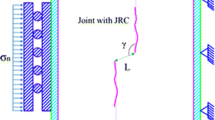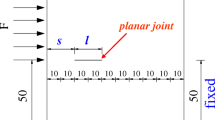Abstract
Direct shear tests on cement mortar samples with symmetrical and asymmetric toothed structural joints were conducted in this study. The main objective is to study the effect of the left undulation angle (i1), the right undulation angle (i2), and the length (l) of the undulation body on the shear properties of artificial jointed rock samples. The test results show that for artificial rock samples with through-symmetrical toothed structural joints (i1 = i2), there is a significant increase in the shear strength and cohesion c of the test specimens when i1 remains constant and l gradually increases. An increase occurs in the shear strength and internal friction angle φ when there is a gradual increase in i1 and l remains constant. For those samples with through-asymmetrical toothed structural joints (i1 ≠ i2), there is a significant increase in the shear strength and cohesion c of the test specimens when i1 remains constant and l gradually increases, and the shear strength of the specimen first increases and then decreases when i1 increases from 15° to 75° and l remains constant.















Similar content being viewed by others
References
Yang ZY, Chiang DY (2000) An experimental study on the progressive shear behavior of rock joints with tooth-shaped asperities. Int J Rock Mech Min Sci 37:1247–1259
Jafari MK, Hosseini KA, Pellet F, Boulon M, Buzzi O (2003) Evaluation of shear strength of rock joints subjected to cyclic loading. Soil Dyn Earthq Eng 23:619–630
Xue FG, Julian PS, Chris MH (2003) Direct shear test of sandstone–concrete joints. Int J Geomech 3:21–33
Ghazvinian AH, Taghichian A, Hashemi M, Mar’ashi SA (2010) The shear behavior of bedding planes of weakness between two different rock types with high strength difference. Rock Mech Rock Eng 43:69–87
Hu YF, Peng ZB, Liu QY (2012) Numerical analysis for shear characteristic of soft structure plane with regular curved edge. Chin J Shenyang Univ Technol 34:710–714 [In Chinese]
Atapour H, Moosavi M (2013) Some effects of shearing velocity on the shear stress-deformation behaviour of hard-soft artificial material interfaces. Geotech Geol Eng 31:1603–1615
Bahaaddini M, Hagan PC, Mitra R, Hebblewhite BK (2015) Parametric study of smooth joint parameters on the shear behaviour of rock joints. Rock Mech Rock Eng 48:923–940
Huang D, Huang RQ, Lei P (2014) Shear deformation and strength of through-going saw-tooth rock discontinuity. J China Coal Soc 39:1229–1237 [In Chinese]
Lee SW, Jeong DW, Lee SW, Lee SW (2014) Influence of asperity characteristics on plane interface shear behavior. KSCE J Civ Eng 18:742–750
Jahanian H, Sadaghiani MH (2015) Experimental study on the shear strength of sandy clay infilled regular rough rock joints. Rock Mech Rock Eng 48:907–922
Bahaaddini M, Hagan PC, Mitra R, Khosravi MH (2016) Experimental and numerical study of asperity degradation in the direct shear test. Eng Geol 204:41–52
Bahaaddini M (2017) Effect of boundary condition on the shear behaviour of rock joints in the direct shear test. Rock Mech Rock Eng 50:1141–1155
Zhang XB, Jiang QH, Kulatilake PHSW, Xiong F, Yao C, Tang ZC (2019) Influence of asperity morphology on failure characteristics and shear strength properties of rock joints under direct shear tests. Int. J. Geomech. 19:04018196(1)–04018196(13)
Zhou H, Chen GT, Zhu Y, Chen J (2019) Experimental study of shear deformation characteristics of marble dentate joints. Rock Soil Mech 40:852–860 [In Chinese]
Shen MR, Zhang QZ (2010) Experimental study of shear deformation characteristics of rock mass discontinuities. Chin J Rock Mechan Eng 29:713–719 [In Chinese]
Mahdi Niktabar SM, Rao KS, Shrivastava AK (2017) Effect of rock joint roughness on its cyclic shear behavior. J Rock Mech Geotech Eng 9:1071–1084
Xiong LX, Chen HJ (2020) Effects of high temperatures and loading rates on the splitting tensile strength of jointed rock mass. Geotech Geol Eng 38:1885–1898
Zhang QZ, Shen MR, Ding WQ (2012) Study on the mechanical properties of rock mass discontinuity under shear condition. Hydrogeol Eng Geol 39:37–42 [In Chinese]
Wang YC, Li J, Ji F, Cai GJ, Qi H (2015) Research on bidirectional shear and stress distribution of asymmetric tooth structural joint. Yangtze River 45:88–91 [In Chinese]
Asadi MS, Rasouli V, Barla G (2012) A bonded particle model simulation of shear strength and asperity degradation for rough rock fractures. Rock Mech Rock Eng 45:649–675
Acknowledgements
This work was supported by the Supported by the Systematic Project of Guangxi Key Laboratory of Disaster Prevention and Engineering Safety (Grant No. 2019ZDK051), and the Open Research Fund of State Key Laboratory of Simulation and Regulation of Water Cycle in River Basin(China Institute of Water Resources and Hydropower Research, Grant No. IWHR-SKL-201708).
Author information
Authors and Affiliations
Corresponding author
Additional information
Publisher's Note
Springer Nature remains neutral with regard to jurisdictional claims in published maps and institutional affiliations.
Rights and permissions
About this article
Cite this article
Xiong, L., Chen, H. & Zhang, Y. Shear Mechanical Properties of Artificial Rock Specimen with Symmetrical and Asymmetric Toothed Structural Joints. Indian Geotech J 51, 347–358 (2021). https://doi.org/10.1007/s40098-020-00455-x
Received:
Accepted:
Published:
Issue Date:
DOI: https://doi.org/10.1007/s40098-020-00455-x




